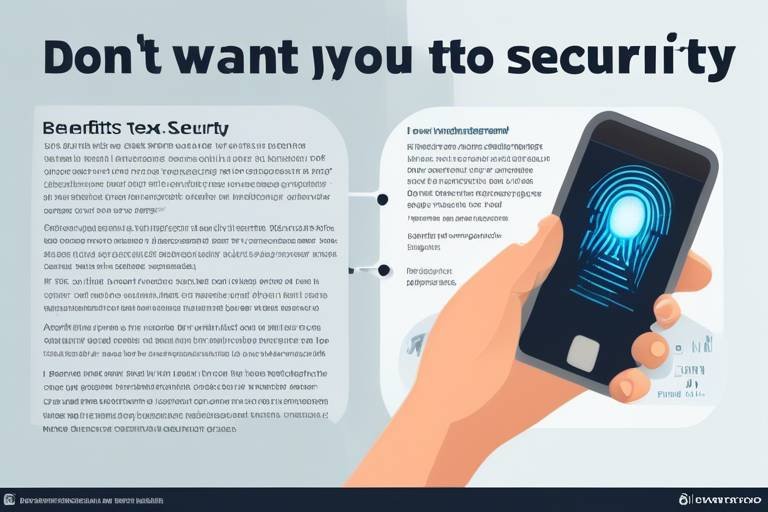Common Internet Scams and How to Avoid Them
In our increasingly digital world, the internet can feel like a vast ocean of opportunities. However, lurking beneath the surface are various internet scams that can catch even the most vigilant users off guard. From phishing attempts to fake e-commerce sites, these scams are designed to exploit our trust and naivety. Understanding the characteristics of these scams is crucial in protecting your personal information and financial security.
Imagine walking through a bustling marketplace, where every vendor seems friendly and trustworthy. Now, picture a few shady characters trying to sell you counterfeit goods or trick you into giving away your hard-earned money. This scenario is not far from what happens online. The internet can be a double-edged sword, offering great benefits while also posing significant risks. By familiarizing yourself with common scams, you can navigate this digital landscape more safely.
One of the most prevalent types of scams is phishing. These deceptive attempts often come disguised as emails or messages from reputable organizations, trying to lure you into revealing sensitive information. It's like receiving a letter that looks official but is actually a cleverly crafted trap. Recognizing the signs of phishing can significantly reduce your risk of falling victim to these tactics. Always check the sender's email address, look for grammatical errors, and be wary of unsolicited requests for personal information.
Another area rife with scams is online shopping. With the rise of e-commerce, scammers have become adept at creating fake websites or listings that trick consumers into purchasing nonexistent products. It’s like finding a beautiful dress in a store window, only to discover it was never for sale. Awareness of red flags can help shoppers make informed decisions. For example, if a deal seems too good to be true, it probably is. Always verify the legitimacy of a website before clicking that “buy” button.
To help you stay safe while shopping online, consider these tips:
- Check Website Security: Always look for “HTTPS” in the URL, which indicates a secure connection. This simple step can protect you from fraud.
- Read Customer Reviews: Research feedback from previous buyers to gauge a website's legitimacy. A site with numerous complaints is a red flag.
Investment scams are another common threat, often promising high returns with little risk. These schemes prey on individuals eager for financial growth, much like a siren luring sailors to their doom. Understanding common tactics can help you avoid falling prey to these scams. If someone promises you the moon and stars with minimal effort, it's time to take a step back and evaluate the situation critically.
Tech support scams also deserve your attention. These scams involve fraudulent calls or pop-ups claiming to offer technical assistance. Picture receiving a call from someone insisting they need to fix your computer, but in reality, they’re just looking to exploit your trust. Recognizing these scams can prevent unnecessary expenses and protect your personal data from being compromised. Always remember, legitimate tech support will never initiate contact without your request.
So, how can you identify a tech support scam? Look out for unsolicited calls or alarming messages that create a sense of urgency. If you feel pressured to act quickly, it’s likely a scam. If you find yourself targeted, knowing the right steps to take can mitigate damage. Reporting the incident and securing your accounts can help restore safety and security.
Finally, let’s talk about romance scams. These scams exploit emotional connections, often through online dating platforms. It’s heart-wrenching to think that someone might manipulate your feelings for financial gain. Recognizing red flags in online relationships, such as requests for money or reluctance to meet in person, is crucial in protecting yourself. Just as you wouldn’t hand over your wallet to a stranger on the street, you shouldn’t send money to someone you’ve never met face-to-face.
Staying safe online, especially in the realm of dating, is vital. Verify identities, maintain privacy, and trust your instincts. If something feels off, it probably is. By practicing these safety measures, you can enjoy the benefits of online dating without falling victim to scams.
Q: What should I do if I think I've been scammed?
A: If you believe you've been scammed, immediately report the incident to your local authorities and the platform where the scam occurred. Change your passwords and monitor your accounts for any suspicious activity.
Q: How can I tell if an email is a phishing attempt?
A: Look for signs such as generic greetings, poor grammar, and urgent requests for personal information. Always verify the sender's email address before clicking on any links.
Q: Are all online shopping sites safe?
A: Not all online shopping sites are safe. Always check for secure connections (HTTPS), read customer reviews, and be cautious of deals that seem too good to be true.
Q: What are some common signs of a tech support scam?
A: Common signs include unsolicited calls, alarming messages about viruses, and requests for remote access to your computer. Legitimate tech support will not initiate contact without your request.
Q: How can I protect myself from romance scams?
A: Protect yourself by verifying identities, avoiding sharing personal information too soon, and being cautious of anyone who asks for money or refuses to meet in person.

Phishing Scams
This article explores various internet scams, their characteristics, and practical tips for avoiding them. Understanding these scams helps protect personal information and financial security in the digital age.
Phishing scams are deceptive attempts to obtain sensitive information by masquerading as trustworthy entities. These scams can take many forms, from emails that look like they’re from your bank to messages that appear to be from popular online services. The goal is simple: to trick you into revealing your personal information, such as passwords or credit card numbers. Imagine receiving an email that seems to be from your favorite online store, offering you a fantastic deal. You’re excited, but that excitement can quickly turn to regret if you fall for the trap.
Recognizing the signs of phishing can significantly reduce the risk of falling victim to these tactics. Here are some common indicators to watch out for:
- Generic Greetings: Emails that start with "Dear Customer" instead of your name can be a red flag.
- Urgent Language: Messages that create a sense of urgency, like "Your account will be suspended!" are often scams.
- Suspicious Links: Hover over links to see the actual URL. If it looks strange or doesn’t match the sender, don’t click it.
Phishing scams can also occur through phone calls, known as vishing (voice phishing). In these cases, scammers may impersonate legitimate companies, claiming they need to verify your information. Always be skeptical and verify the caller's identity before providing any information.
One effective way to protect yourself is to use two-factor authentication (2FA) whenever possible. This adds an extra layer of security, making it harder for scammers to access your accounts even if they obtain your password. Think of it as a double lock on your front door; it makes it much tougher for unwanted visitors to get in.
Additionally, regularly updating your passwords and using strong, unique passwords for different accounts can significantly enhance your online security. Consider using a password manager to keep track of your passwords securely. This way, you won’t have to remember every single one, and it reduces the temptation to use easily guessable passwords.
In conclusion, being aware of phishing scams and their characteristics is your first line of defense in the digital world. By staying informed and adopting best practices for online security, you can protect your personal information and financial security from these cunning tactics. Remember, if something seems too good to be true, it probably is!
1. What should I do if I think I've been phished?
If you suspect you've fallen for a phishing scam, immediately change your passwords and enable two-factor authentication on your accounts. Contact your bank or service provider to report the incident.
2. How can I identify a phishing email?
Look for generic greetings, urgent messages, and suspicious links. Always verify the sender's email address before clicking on any links or providing information.
3. Can phishing scams happen through social media?
Yes, phishing scams can occur on social media platforms. Be cautious of unsolicited messages that ask for personal information or direct you to unfamiliar websites.

Online Shopping Scams
Online shopping has revolutionized the way we buy products, bringing convenience right to our fingertips. However, this ease of access also comes with its fair share of risks. are prevalent and can lead to significant financial loss and emotional distress. These scams often involve fake websites or listings that trick consumers into purchasing nonexistent products. Imagine browsing your favorite online store, adding items to your cart, and clicking "checkout," only to realize that the website was a façade designed to steal your money and personal information. It's a nightmare scenario, but it happens more often than you might think.
To navigate the murky waters of online shopping safely, it's essential to be aware of the common red flags that indicate a potential scam. For instance, if a deal seems too good to be true, it probably is. Scammers often lure customers with incredibly low prices on popular items, enticing them to make a purchase without doing proper research. Additionally, if you come across a website with numerous spelling errors or poor-quality images, it's a sign that you should proceed with caution. Always remember, a legitimate business takes pride in its presentation.
Fake e-commerce websites are particularly dangerous as they closely mimic legitimate retailers, making it difficult for the average shopper to differentiate between the two. These sites are designed to steal your money and personal information, leaving you with nothing but regret. To protect yourself, it’s crucial to learn how to identify these fraudulent sites. Look for inconsistencies in the website's URL; often, scammers will use a URL that is similar but not identical to the real one. For example, instead of "www.reputablebrand.com," you might see "www.reputablebrandstore.com." Always double-check the URL before making a purchase.
One of the most effective ways to ensure a website’s security is by checking for the HTTPS protocol in the URL. This indicates that the website is using a secure connection to protect your data. A padlock icon in the address bar is another good sign. Before entering any personal information during online transactions, always verify these security indicators. If you don’t see them, it’s better to err on the side of caution and look for alternatives.
Another key tactic in avoiding online shopping scams is to read customer reviews. These reviews can provide invaluable insights into a website's legitimacy. Look for feedback from previous buyers to gauge their experiences. Were they satisfied with their purchases? Did they receive their items on time? If you notice a pattern of negative reviews or complaints about products not being delivered, it’s a red flag that should not be ignored. Researching feedback before making a purchase can save you from potential scams and ensure a safer shopping experience.
In conclusion, while online shopping offers unparalleled convenience, it's essential to remain vigilant. By recognizing the signs of online shopping scams and taking proactive measures to protect yourself, you can enjoy the benefits of e-commerce without falling victim to fraud. Always trust your instincts—if something doesn’t feel right, it probably isn’t.
| Question | Answer |
|---|---|
| How can I identify a fake online store? | Look for inconsistencies in the URL, check for HTTPS security, and read customer reviews. |
| What should I do if I think I've been scammed? | Contact your bank or credit card company immediately, report the scam to the authorities, and monitor your accounts for suspicious activity. |
| Are online shopping scams common? | Yes, they are quite common, especially during holiday seasons when people are eager to find deals. |

Fake E-commerce Websites
In today's digital marketplace, the convenience of online shopping comes with its own set of challenges, particularly the rise of . These deceptive sites are designed to look like legitimate retailers, tricking unsuspecting shoppers into providing their personal information and hard-earned money. Imagine walking into a store that looks just like your favorite shop, only to find out it’s a complete facade. This is the reality for many who fall victim to these scams.
So, how can you spot these fraudulent websites before it's too late? First and foremost, look for signs of legitimacy. A real e-commerce site typically has a professional design, clear branding, and a well-structured layout. If a website looks hastily put together, with low-quality images or awkward text, consider it a red flag. Additionally, check for contact information. Legitimate businesses provide multiple ways to reach them, including phone numbers, email addresses, and physical locations. If you can’t find any of this information, it’s best to steer clear.
Another critical factor is the presence of secure payment options. Reputable websites offer various payment methods, including credit cards and trusted payment processors like PayPal. If a site only accepts wire transfers or cryptocurrency, it’s a strong indication that they may not be trustworthy. Furthermore, always look for security indicators such as HTTPS in the URL, which signifies that the site is using encryption to protect your data.
Here’s a quick checklist to help you identify a fake e-commerce website:
- Check the URL: Look for misspellings or unusual domain endings.
- Read the reviews: Search for customer feedback on independent review sites.
- Look for a return policy: Legitimate sites have clear return and refund policies.
Understanding these characteristics can significantly reduce your chances of being scammed. Remember, if an offer seems too good to be true, it probably is. Always do your research and trust your instincts when shopping online. By staying informed and cautious, you can enjoy the benefits of online shopping without falling prey to scams.

Checking Website Security
This article explores various internet scams, their characteristics, and practical tips for avoiding them. Understanding these scams helps protect personal information and financial security in the digital age.
Phishing scams are deceptive attempts to obtain sensitive information by masquerading as trustworthy entities. Recognizing the signs of phishing can significantly reduce the risk of falling victim to these tactics.
Online shopping scams often involve fake websites or listings that trick consumers into purchasing nonexistent products. Awareness of red flags can help shoppers make informed decisions and avoid financial loss.
Fake e-commerce websites mimic legitimate retailers to steal money and personal information. Learning how to identify these sites is crucial for safe online shopping experiences.
When shopping online, is a critical step that can safeguard you from falling victim to scams. One of the first things to look for is the presence of HTTPS in the website URL. This indicates that the site is using a secure protocol for data transmission, which encrypts your information during transactions. If you see just HTTP, it’s a warning sign that your data could be at risk.
Additionally, look for a small padlock icon in the address bar of your browser. This symbol is another indicator that the website is secure. However, be cautious—some fraudulent sites may also display a padlock, so it's essential to conduct further checks. You can also verify the website's legitimacy by checking its privacy policy and contact information. A reputable site usually has clear policies that outline how they handle your personal data and provide multiple ways for you to contact them.
Another useful tool is to utilize online services that assess website security. Websites like SSL Shopper can help you determine whether a site is secure. These tools can provide a comprehensive report on the site's SSL certificate status, which is essential for online transactions.
Lastly, be wary of deals that seem too good to be true. If a website offers products at prices significantly lower than those found on well-known retail sites, it’s a red flag. Always take the time to research the site and read customer reviews before making any purchases. A little diligence can go a long way in protecting your financial and personal information.
Investment scams promise high returns with little risk, often targeting individuals seeking financial growth. Understanding common tactics can help potential investors avoid falling prey to these schemes.
Tech support scams involve fraudulent calls or pop-ups claiming to offer technical assistance. Recognizing these scams can prevent unnecessary expenses and protect personal data from being compromised.
Identifying signs of tech support scams, such as unsolicited calls or alarming messages, is essential for safeguarding your devices and personal information from exploitation.
Knowing the steps to take if targeted by a tech support scam can mitigate damage. Reporting the incident and securing your accounts can help restore safety and security.
Romance scams exploit emotional connections to defraud individuals, often through online dating platforms. Awareness of common tactics can help individuals protect their hearts and finances from manipulation.
Recognizing red flags in online relationships, such as requests for money or reluctance to meet in person, can protect individuals from falling victim to romance scams.
Practicing online safety, including verifying identities and maintaining privacy, is crucial when engaging in online dating to avoid potential scams and emotional distress.
Q: What should I do if I suspect a website is a scam?
A: If you suspect a website is a scam, do not enter any personal information. You can report the site to consumer protection agencies and check online forums for user experiences.
Q: How can I tell if an email is a phishing attempt?
A: Look for poor spelling and grammar, generic greetings, and urgent requests for personal information. Always verify the sender's email address.
Q: What steps should I take if I fall victim to a scam?
A: Immediately change your passwords, monitor your bank accounts for unauthorized transactions, and report the scam to the proper authorities.

Reading Customer Reviews
When it comes to online shopping, customer reviews are your best friend. They can be the difference between a successful purchase and a costly mistake. Imagine stepping into a store where you can hear the whispers of previous customers, sharing their experiences about the products and services. That’s exactly what reviews provide—a glimpse into the reality of what you’re considering buying. However, not all reviews are created equal, and knowing how to interpret them is crucial.
First and foremost, look for reviews that are detailed and specific. A review that simply states, “Great product!” doesn’t give you much information. Instead, seek out reviews that discuss aspects like the product's quality, usability, and customer service experiences. For instance, a review might say, “The shoes were comfortable for all-day wear, and the customer service was responsive when I had an issue with my order.” This kind of detail helps you gauge whether the product is worth your time and money.
Moreover, be wary of overly positive reviews. If a product has an overwhelming number of five-star ratings with vague comments, it could be a red flag. Sometimes, companies pay for fake reviews to enhance their reputation. To counter this, check for a mix of reviews—positive, neutral, and negative. A product with a few negative reviews, particularly if they address specific issues, can be more trustworthy than one with only glowing feedback. It’s like finding a restaurant that has a few bad reviews; it often means the place is genuine and has room for improvement.
Another critical aspect is to consider the timing of the reviews. Look at how recent they are. A product might have been great a few years ago, but if the latest reviews indicate declining quality or service, it’s a warning sign. In addition, pay attention to the overall sentiment. If you notice a pattern in the reviews, such as multiple complaints about shipping delays or product defects, it’s wise to take those concerns seriously.
Lastly, don’t forget to check the platform where the reviews are posted. Some websites allow sellers to filter reviews or even remove negative feedback. It’s always a good idea to cross-reference reviews across multiple platforms. For instance, if you’re considering a gadget, check reviews on tech forums, the retailer’s site, and independent review sites to get a well-rounded view.
In summary, reading customer reviews is not just about looking for a star rating; it’s about digging deeper to understand the product and the seller. By taking the time to analyze reviews critically, you can protect yourself from potential scams and make informed purchasing decisions that save you time and money.
- What should I do if I find negative reviews? - Negative reviews should prompt you to investigate further. Look for patterns and see if the issues mentioned are deal-breakers for you.
- Are all reviews trustworthy? - No, some reviews can be fake or biased. Always cross-check reviews on multiple platforms to get a clearer picture.
- How can I report a fake review? - Most e-commerce platforms have a process for reporting suspicious reviews. Look for a “Report” button or contact customer service for assistance.

Investment Scams
Investment scams are a pervasive threat in today's digital landscape, often preying on individuals who are eager to grow their wealth. These scams typically promise high returns with minimal risk, which can sound incredibly appealing, especially to those who may not have extensive financial knowledge. Picture this: you stumble upon an ad that boasts of a unique investment opportunity, claiming you can double your money in just a few weeks. It's tempting, right? But here's the catch – if it sounds too good to be true, it probably is!
These scams often come in various forms, including Ponzi schemes, pyramid schemes, and fraudulent investment platforms. They may use persuasive tactics, such as social proof, where they showcase testimonials from supposed "happy investors." However, these testimonials are often fabricated or exaggerated. To help you navigate this minefield, it’s crucial to understand some common tactics used by scammers.
- Pressure Tactics: Scammers often create a sense of urgency, pushing you to invest quickly before the "opportunity" disappears.
- Unlicensed Investment Advisors: Many scammers pose as financial advisors without the necessary licenses or credentials.
- Complex Strategies: They may use complicated jargon or elaborate strategies to confuse potential investors.
Recognizing these red flags can significantly reduce your chances of falling victim to an investment scam. Always conduct thorough research before committing any funds. Look for verified information about the investment opportunity and the individuals involved. Check for registration with regulatory bodies, such as the Securities and Exchange Commission (SEC) in the United States, which can help validate the legitimacy of an investment.
Moreover, consider consulting a trusted financial advisor who can provide unbiased advice and help you make informed decisions. Remember, legitimate investments carry risks, but scammers exploit the desire for quick profits to lure individuals into their traps. Stay vigilant, and don’t let your eagerness for financial growth cloud your judgment!
| Question | Answer |
|---|---|
| What are the signs of an investment scam? | Common signs include promises of high returns, pressure to invest quickly, and lack of transparency about the investment. |
| How can I verify an investment opportunity? | Research the company and its executives, check for registration with regulatory bodies, and read reviews from other investors. |
| What should I do if I suspect a scam? | Report it to the relevant authorities, such as the SEC, and consider consulting a financial advisor for guidance. |

Tech Support Scams
In a world where technology is an integral part of our daily lives, have become alarmingly prevalent. These scams often involve fraudulent calls or pop-ups that claim to offer technical assistance for your computer or device. Imagine this: you’re casually browsing the internet when suddenly, a pop-up appears, warning you that your system is infected with a virus. The message urges you to call a number to “fix” the issue. Sounds scary, right? But here’s the catch: these messages are typically designed to instill fear and urgency, tricking you into providing personal information or even allowing remote access to your device. Recognizing these scams is crucial for protecting your personal data and financial security.
One of the most common tactics used by scammers is to impersonate legitimate tech companies, like Microsoft or Apple. They often use spoofed phone numbers and official-looking websites to lend credibility to their claims. If you receive an unsolicited call from someone claiming to be from a well-known tech company, take a moment to pause and think: why would they be calling you? Legitimate companies typically do not reach out to customers in this manner. Instead, they encourage users to contact them through official channels if they need help.
There are several signs that can help you identify a tech support scam:
- Unsolicited Contact: If you didn’t initiate the contact, be suspicious.
- Urgent Language: Scammers often create a sense of urgency to pressure you into immediate action.
- Request for Personal Information: Legitimate tech support will never ask for sensitive information like passwords over the phone.
- Remote Access Requests: Be wary of anyone asking to remotely access your computer; this is a common tactic to gain control over your device.
If you find yourself targeted by a tech support scam, it’s essential to know what steps to take to mitigate potential damage. First, do not engage with the scammer. Hang up the phone or close the pop-up immediately. If you’ve already provided personal information, consider changing your passwords and monitoring your accounts for any suspicious activity. Additionally, report the incident to the appropriate authorities, such as the Federal Trade Commission (FTC) in the United States. They can provide guidance and help others avoid falling victim to similar scams.
Staying informed about the latest tech support scams is vital in today’s digital landscape. Regularly educating yourself about the tactics used by scammers can empower you to protect your devices and personal information. Remember, the best defense against these scams is a well-informed consumer!
Q: What should I do if I think I’ve been scammed?
A: If you suspect you’ve been scammed, immediately disconnect from the internet, change your passwords, and monitor your accounts for any unauthorized transactions. Report the scam to local authorities and relevant consumer protection agencies.
Q: How can I verify if a tech support call is legitimate?
A: If you receive a call from someone claiming to be from a tech company, hang up and contact the company directly using the official number listed on their website. Do not use any numbers provided by the caller.
Q: Are there any tools to help protect against tech support scams?
A: Yes, using reputable antivirus software and keeping your operating system updated can help protect against various online threats, including tech support scams. Additionally, consider using a call-blocking app to filter out suspicious calls.

Signs of a Tech Support Scam
When it comes to tech support scams, being aware of the warning signs can save you from a lot of trouble. These scams often come in the form of unsolicited phone calls or pop-up messages that seem to come from legitimate tech companies. One of the most alarming signs is when you receive a call from someone claiming to be from a well-known company, like Microsoft or Apple, without you having reached out to them first. It's like a stranger knocking on your door and insisting they need to check your plumbing without any prior invitation!
Another red flag to watch out for is the use of high-pressure tactics. Scammers often create a sense of urgency, claiming that your computer is infected with a virus or that your account has been compromised. They might say something like, “If you don’t act now, your data could be lost forever!” This is designed to make you act impulsively, without thinking things through. Remember, legitimate tech support will never rush you into making a decision.
Additionally, be cautious if you are asked to provide personal information, such as your credit card number or social security number. Genuine tech support representatives will not request sensitive information over the phone. If someone is asking for this kind of information, it’s a clear indication that you are dealing with a scam. Furthermore, some scammers may ask you to download software that gives them remote access to your computer. This is a huge red flag; legitimate companies will never ask you to do this without proper verification.
Here are some common signs of tech support scams:
- Unsolicited calls or pop-up messages claiming to be from a reputable company.
- High-pressure tactics to create urgency.
- Requests for personal information or payment over the phone.
- Instructions to download software for remote access.
By keeping an eye out for these signs, you can better protect yourself from falling victim to tech support scams. If you ever feel unsure or uneasy about a communication you’ve received, it’s a good idea to hang up and contact the company directly using a verified number. Trust your instincts; if something feels off, it probably is!
Q: What should I do if I think I've been targeted by a tech support scam?
A: If you believe you've been targeted, immediately disconnect from the internet, run a security scan on your device, and change your passwords. It's also wise to report the scam to your local authorities or the Federal Trade Commission (FTC).
Q: How can I verify if a tech support call is legitimate?
A: Always hang up and contact the company directly using a number from their official website. This way, you can confirm whether the call was genuine or a scam.
Q: Are there any tools to help protect against tech support scams?
A: Yes, using antivirus software and firewalls can help protect your devices. Additionally, keeping your software updated can prevent vulnerabilities that scammers might exploit.

What to Do if Targeted
This article explores various internet scams, their characteristics, and practical tips for avoiding them. Understanding these scams helps protect personal information and financial security in the digital age.
Phishing scams are deceptive attempts to obtain sensitive information by masquerading as trustworthy entities. Recognizing the signs of phishing can significantly reduce the risk of falling victim to these tactics.
Online shopping scams often involve fake websites or listings that trick consumers into purchasing nonexistent products. Awareness of red flags can help shoppers make informed decisions and avoid financial loss.
Fake e-commerce websites mimic legitimate retailers to steal money and personal information. Learning how to identify these sites is crucial for safe online shopping experiences.
Ensuring a website’s security features, like HTTPS, can protect against fraud. Always verify security indicators before entering sensitive information during online transactions.
Customer reviews can provide insights into a website's legitimacy. Researching feedback from previous buyers helps identify potential scams before making a purchase.
Investment scams promise high returns with little risk, often targeting individuals seeking financial growth. Understanding common tactics can help potential investors avoid falling prey to these schemes.
Tech support scams involve fraudulent calls or pop-ups claiming to offer technical assistance. Recognizing these scams can prevent unnecessary expenses and protect personal data from being compromised.
Identifying signs of tech support scams, such as unsolicited calls or alarming messages, is essential for safeguarding your devices and personal information from exploitation.
If you find yourself targeted by a tech support scam, it's crucial to act swiftly and decisively. First and foremost, do not engage with the scammer. This means hanging up the phone or closing any suspicious pop-up windows. Engaging with them can lead to further manipulation or attempts to extract more information from you.
Next, document everything. Take notes of the scammer's phone number, the time of the call, and what was said. This information can be invaluable if you need to report the scam later. After documenting, it’s important to report the incident to the appropriate authorities. In the U.S., you can report tech support scams to the Federal Trade Commission (FTC) through their website. In other countries, check with local consumer protection agencies.
Additionally, secure your accounts. Change passwords for any accounts that may have been compromised or that you suspect could be at risk. Consider enabling two-factor authentication for an extra layer of security. If you provided any personal or financial information, monitor your bank and credit accounts closely for any unusual activity.
Lastly, educate yourself and others. Share your experience with friends and family to help them recognize the signs of tech support scams. The more people are aware, the less likely they are to fall victim to these malicious tactics.
Romance scams exploit emotional connections to defraud individuals, often through online dating platforms. Awareness of common tactics can help individuals protect their hearts and finances from manipulation.
Recognizing red flags in online relationships, such as requests for money or reluctance to meet in person, can protect individuals from falling victim to romance scams.
Practicing online safety, including verifying identities and maintaining privacy, is crucial when engaging in online dating to avoid potential scams and emotional distress.
Q: How can I tell if a website is fake?
A: Look for signs like poor design, lack of contact information, and reviews that seem too good to be true. Always check for HTTPS in the URL.
Q: What should I do if I think I've been scammed?
A: Document the details, report it to the authorities, and monitor your financial accounts closely for any unauthorized transactions.
Q: Can I get my money back if I fall for a scam?
A: It depends on the situation, but reporting the scam quickly can increase your chances of recovering lost funds.

Romance Scams
This article explores various internet scams, their characteristics, and practical tips for avoiding them. Understanding these scams helps protect personal information and financial security in the digital age.
Phishing scams are deceptive attempts to obtain sensitive information by masquerading as trustworthy entities. Recognizing the signs of phishing can significantly reduce the risk of falling victim to these tactics.
Online shopping scams often involve fake websites or listings that trick consumers into purchasing nonexistent products. Awareness of red flags can help shoppers make informed decisions and avoid financial loss.
Fake e-commerce websites mimic legitimate retailers to steal money and personal information. Learning how to identify these sites is crucial for safe online shopping experiences.
Ensuring a website’s security features, like HTTPS, can protect against fraud. Always verify security indicators before entering sensitive information during online transactions.
Customer reviews can provide insights into a website's legitimacy. Researching feedback from previous buyers helps identify potential scams before making a purchase.
Investment scams promise high returns with little risk, often targeting individuals seeking financial growth. Understanding common tactics can help potential investors avoid falling prey to these schemes.
Tech support scams involve fraudulent calls or pop-ups claiming to offer technical assistance. Recognizing these scams can prevent unnecessary expenses and protect personal data from being compromised.
Identifying signs of tech support scams, such as unsolicited calls or alarming messages, is essential for safeguarding your devices and personal information from exploitation.
Knowing the steps to take if targeted by a tech support scam can mitigate damage. Reporting the incident and securing your accounts can help restore safety and security.
Romance scams exploit emotional connections to defraud individuals, often through online dating platforms. These scams can be particularly devastating because they prey on the heart, making it difficult for victims to see the red flags. Imagine forging a deep connection with someone, only to discover that it was all a ruse designed to extract money from you. It's a heartbreaking scenario that many have unfortunately faced.
Awareness of common tactics can help individuals protect their hearts and finances from manipulation. Scammers often create elaborate personas, complete with fake photos and compelling backstories. They may claim to be working overseas or in the military, which adds an element of urgency and drama to their requests for financial assistance. If someone you’ve met online starts asking for money, especially under dubious circumstances, that’s a major red flag.
To help you navigate the murky waters of online romance, here are some key signs to watch out for:
- Too Good to Be True: If their profile seems overly perfect or their love feels instantaneous, proceed with caution.
- Reluctance to Meet: If they consistently avoid meeting in person or video chatting, it could be a sign that they are not who they claim to be.
- Requests for Money: Be wary of any requests for financial help, especially if they create elaborate stories to justify it.
Protecting yourself in the realm of online dating is paramount. Always verify identities through social media or mutual acquaintances when possible. Keep your personal information private until you are completely sure of the person’s intentions. Remember, a genuine relationship will develop naturally over time, without the pressure of financial commitments.
Q: How can I tell if someone is scamming me online?
A: Look out for signs such as reluctance to meet in person, inconsistent stories, and requests for money. Trust your instincts; if something feels off, it probably is.
Q: What should I do if I think I've been a victim of a romance scam?
A: Report the scam to the platform where you met the person, and consider contacting your local authorities. It's also wise to monitor your financial accounts for any suspicious activity.
Q: Can I recover lost money from a romance scam?
A: Recovery can be challenging, but contact your bank or credit card company immediately. They may be able to help if you acted quickly.

Identifying Romance Scams
When it comes to online dating, the excitement of meeting someone new can sometimes cloud our judgment. However, it's crucial to stay vigilant and recognize the signs of romance scams before getting too emotionally invested. These scams often start with seemingly genuine connections, but they can quickly turn into manipulative schemes aimed at extracting money or personal information. One of the first red flags to look out for is the overly romantic language used by the scammer. If someone professes their love for you within days of chatting, it might be a sign that their intentions aren't genuine.
Another common tactic used by scammers is creating a sense of urgency. They may fabricate stories about needing money for a medical emergency or travel expenses, pushing you to act quickly without thinking it through. It's essential to ask yourself, "Would someone I just met really be in such dire straits?" If the answer is no, then trust your instincts and proceed with caution. Additionally, be wary of individuals who are reluctant to meet in person or engage in video calls. This reluctance can indicate that they are hiding their true identity.
Furthermore, researching the person can provide valuable insights. A simple reverse image search can reveal if their profile pictures are stolen from someone else's account. If their online presence seems too perfect or non-existent outside of the dating platform, it could be another indicator of a scam. It's also beneficial to have open conversations with friends or family about your online interactions. They can offer an outside perspective and may notice red flags that you might overlook due to emotional involvement.
In summary, identifying romance scams requires a combination of skepticism and awareness. By paying attention to the signs and trusting your gut feelings, you can protect yourself from falling victim to these emotional and financial traps. Remember, it's better to be safe than sorry when it comes to matters of the heart.
- What should I do if I suspect I am talking to a scammer? If you suspect you're dealing with a scammer, cease all communication immediately and report the profile to the dating site. You can also warn others by sharing your experience.
- How can I protect myself while dating online? Always verify the identity of the person you are talking to, avoid sharing personal information too soon, and trust your instincts. If something feels off, it probably is.
- Are romance scams common? Yes, romance scams are unfortunately quite common, and they continue to evolve as scammers become more sophisticated in their tactics.
- Can I get my money back if I fall victim to a romance scam? Recovering lost money can be difficult, but you should report the scam to your bank or credit card company immediately. They may be able to assist you in recovering funds.

Staying Safe Online
This article explores various internet scams, their characteristics, and practical tips for avoiding them. Understanding these scams helps protect personal information and financial security in the digital age.
Phishing scams are deceptive attempts to obtain sensitive information by masquerading as trustworthy entities. Recognizing the signs of phishing can significantly reduce the risk of falling victim to these tactics.
Online shopping scams often involve fake websites or listings that trick consumers into purchasing nonexistent products. Awareness of red flags can help shoppers make informed decisions and avoid financial loss.
Fake e-commerce websites mimic legitimate retailers to steal money and personal information. Learning how to identify these sites is crucial for safe online shopping experiences.
Ensuring a website’s security features, like HTTPS, can protect against fraud. Always verify security indicators before entering sensitive information during online transactions.
Customer reviews can provide insights into a website's legitimacy. Researching feedback from previous buyers helps identify potential scams before making a purchase.
Investment scams promise high returns with little risk, often targeting individuals seeking financial growth. Understanding common tactics can help potential investors avoid falling prey to these schemes.
Tech support scams involve fraudulent calls or pop-ups claiming to offer technical assistance. Recognizing these scams can prevent unnecessary expenses and protect personal data from being compromised.
Identifying signs of tech support scams, such as unsolicited calls or alarming messages, is essential for safeguarding your devices and personal information from exploitation.
Knowing the steps to take if targeted by a tech support scam can mitigate damage. Reporting the incident and securing your accounts can help restore safety and security.
Romance scams exploit emotional connections to defraud individuals, often through online dating platforms. Awareness of common tactics can help individuals protect their hearts and finances from manipulation.
Recognizing red flags in online relationships, such as requests for money or reluctance to meet in person, can protect individuals from falling victim to romance scams.
When it comes to , a proactive approach is your best defense. The internet can be a wild west of scams and deceit, but with a few simple habits, you can navigate it safely. First, always verify identities before engaging in any online interactions, especially in dating scenarios. Just like you wouldn’t give your home address to a stranger on the street, don’t share personal information with someone you’ve just met online.
Privacy settings on social media platforms are your friends! Make sure to adjust these settings to limit who can see your personal information. Think of it as putting up a fence around your yard; it keeps unwanted visitors out. Additionally, be cautious about what you post online. Even seemingly harmless details can be pieced together by scammers to create a profile of you.
Another crucial point is to use strong passwords and change them regularly. A strong password is like a solid lock on your door—it's your first line of defense against intruders. Consider using a password manager to keep track of your passwords securely. This way, you won’t have to remember every single one, and you can ensure each account has its unique password.
Lastly, educate yourself about the latest scams. Just as the weather changes, so do the tactics used by scammers. Staying informed can help you recognize suspicious activity. Websites, forums, and even local news outlets often report on current scams, so keep your eyes peeled for the latest information.
- What should I do if I think I've been scammed? If you suspect you've fallen victim to a scam, report it to your local authorities and the relevant online platforms. Change your passwords and monitor your financial accounts closely.
- How can I recognize a phishing email? Look for poor grammar, generic greetings, and suspicious links. Legitimate companies usually address you by name and maintain a professional tone.
- Are there any tools to help protect against scams? Yes! Consider using antivirus software, a VPN for secure browsing, and browser extensions that flag suspicious websites.
Frequently Asked Questions
- What are phishing scams and how can I recognize them?
Phishing scams are deceptive attempts to steal sensitive information by pretending to be trustworthy sources, like banks or popular websites. You can recognize them by looking for suspicious emails or messages that contain urgent requests for personal information, misspellings, or unfamiliar sender addresses.
- How can I avoid online shopping scams?
To steer clear of online shopping scams, always check for secure website connections (look for HTTPS), read customer reviews, and be cautious of deals that seem too good to be true. If a website lacks contact information or has poor customer service, it's best to shop elsewhere.
- What should I do if I encounter a fake e-commerce website?
If you stumble upon a fake e-commerce site, do not provide any personal information. Report the website to your browser and local authorities. Additionally, you can warn others by leaving reviews on legitimate platforms.
- What are the signs of a tech support scam?
Common signs of tech support scams include unsolicited calls claiming to be from tech companies, pop-up messages on your computer warning of viruses, and requests for remote access to your device. Always hang up or close the pop-up and verify the legitimacy of any claims independently.
- How can I protect myself from romance scams?
To protect yourself from romance scams, be wary of individuals who request money or seem reluctant to meet in person. Always verify their identity through video calls or social media, and trust your instincts—if something feels off, it probably is.
- What steps should I take if I'm targeted by a scam?
If you find yourself targeted by a scam, the first step is to stop all communication with the scammer. Next, report the incident to relevant authorities and your bank if financial information was shared. Finally, consider monitoring your accounts for any unusual activity.



















